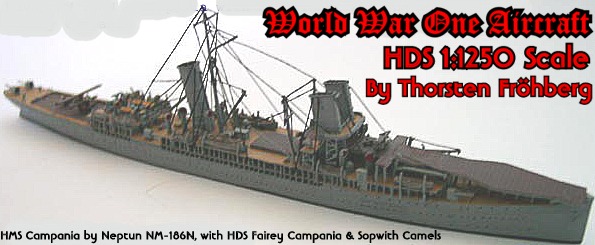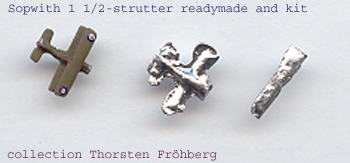 |
 |
These are finished kits of World War One 1:1250 scale plane models.(see the picture of the Sopwith 1½-strutter). I got them from Heinz-Dieter Schlingelhof, who makes models under the name HDS. Normally he sells only readymade models, but as we know each other very well, I was lucky to get kits to assemble.
 |
He made these kits, because I asked so often for them - he had no choice….. I also gave him some plans, for the Handley-Page O/400, the Gotha G V, Fokker D VII, Short bomber and Fairey Campania for example.
The models are made of metal in casting forms made of gypsum. Therefore the kits are not as accurate as these from Neptun or CAP Aero. There is a lot of work still to do (again: take a look at the Sopwith 1½-strutter). The Caproni Ca 46 was especially difficult to finish. The two fuselage halves for example were cast in one piece. So I had to pierce the first half with a thin nail. Than I took sand paper and formed a little cylinder from it, which I used to polish the fuselages. I don’t remember how long it took – quite a few evenings were through before it was done good enough to be painted. The painting was comparatively simple. First it was painted gray overall and than the green was added with a fine brush, I first thinned it out a bit. The last step, which is the same for every model, were the cockades. These were painted on by using a toothpick. First a drop of paint was enlarged by swirling it around in a circle. After that was dry, the next little smaller drop was added in the same process and finally the inner circle with a very little drop.
To finish it completely, I used some very fine pieces of wire to fix as guns or
on other models as a cooler (for example the Hansa-Brandenburg
W 12 has it in front of the wings - difficult to recognize on the
picture). The painting of the Gotha and AEG bombers as well as the
Fokker D VII fighters took a lot longer.
For the Gothas I choose beige for the
first overall painting and than dotted, again with a toothpick, the other
colours on the plane for the mottled camouflage. Colour by colour was added step
by step, so I had to take care to leave enough space for the other colour drops
with each step. The AEGs were first
painted in blue. The Fokker D VIIs that I own are of different colour schemes. This one in silver/green is in a
scheme I found for an Albatros D V in
the book "Fighters 1914-1919"
by Kenneth Munson, which I liked very much. As I have no Albatros fighter, and HDS has not yet produced one, I choose to paint one of my D
VIIs that way. The other one I have is in a real scheme for a D
VII, that I found in "Enzyklopädie
der Flugzeuge" (encyclopaedia of planes) part one by Enzo
Angelucci (blue fuselage, red nose, spotted wings also).
All in all a lot of work, but the result is quite satisfying, I think. By the
way: HDS is still producing. But as every single plane has to be finished
by hand with all of the work that I depicted above, one has to estimate a price
of around 20 Euros for one large plane, such as the Handley-Page
O/400, or the Felixtowe / Curtiss flying boats.
Thorsten Fröhberg